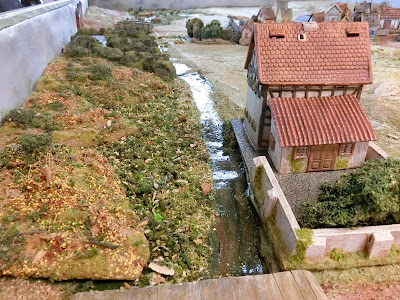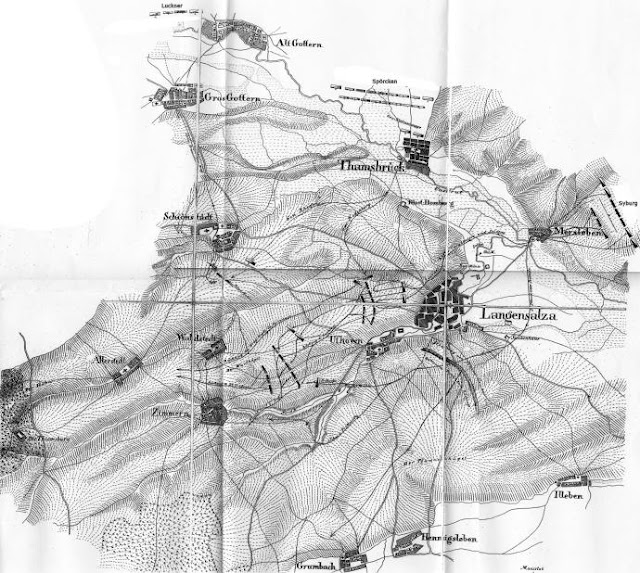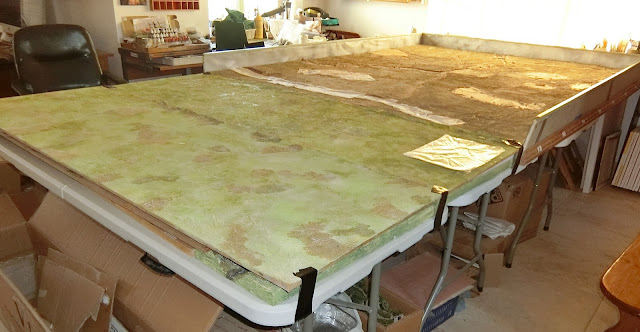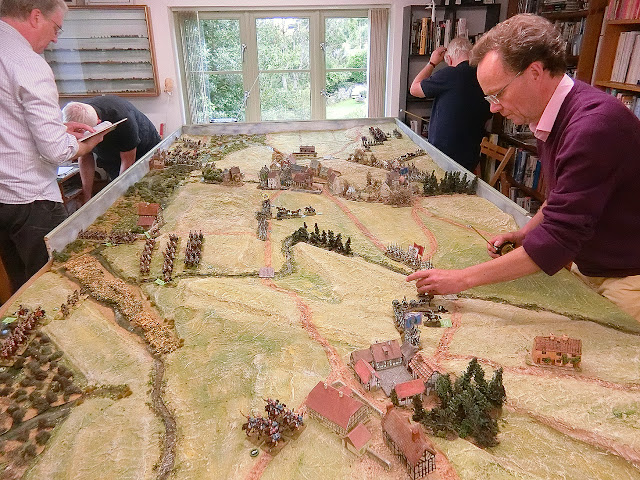Once a year, if I can, I try to do a sculpted terrain on the extended table. Many readers will remember the 12 feet x 8 feet setups for Waterloos x 4 , and four days of playing Quatre Bras, and the two big games in The Raid on Vestisle. COVID lockdowns put paid to that in 2020 (though I have still to blog on the excitement I got up to that year!) So in 2021, after the Brampton terrain and all the spin-off games on that 8 x 6 table in May and June it was time to Go Large again. But what to do?
As usual I asked my mates and it emerged that Guy wanted to use his new modest-sized Crann Tara Saxon Army, and I was keen to exercise my newly painted RSM95 Hanoverians. I looked in the masterwork on the Saxon Army "Between Scylla and Charybdis" by Helion & Co, and found in Part II page 78 The Combat at Langensalza. This battle had manageable numbers of Saxons and French fighting an Allied force of Hanoverians, Hessians and Prussians, it seemed ideal. Emails with Guy and a bit more digging revealed that the same description of the battle was in Kronoscaf but with the great advantage of full orders of battle of all the units on both sides which were within marching distance of the battle area. There was also a difficult-to-read old map reproduced there. Combat at Langensalza
Very handily you can click through for the majority of regiments to find their uniforms too. This was particularly useful for me as I had to work out which units from our collections best represented the scaled down formations we needed to make a balanced game. Paul B had kindly offered his Prussians and Austrians to help out as required.
 |
| Just as a teaser - Paul and Guy with the first Move's units on the table at Langensalza, about 50% more were still to arrive in due course |
Historical setting
I try not to do too much boring history on the blog but a bit of background is necessary for this. The Prussians captured and dispersed a lot of the Saxon Army in the Autumn of 1756. What was not absorbed into the Prussian army got away to fight either alongside Austria in Bohemia and Silesia and Saxony or across Germany to become part of the French Army. By February 1761 it appears that a corps of around 10,000 Saxons was a formal part of the French order of battle within a French-officered hierarchy and holding a key part of the front line against the Western Alliance in Hesse/Thuringia.
As the Kronoscaf account tells, by mid February the Hanoverian/Hessian/Prussian Allies assembled a force across the River Unstrut from the town of Langensalza where the Saxons were based, and managed to bridge the overflowing river and the marshes either side to try to take the Saxons by surprise. It seems evident that the Saxons weren't caught completely napping as by dawn they had a strong infantry brigade on high ground overlooking the river.
To summarise briefly - the Allies were dominant in cavalry which they sent across the river first, by two or three routes; the Saxons began to retreat but were eventually surrounded. Another Saxon Division under French control arrived but did not stick around. A lot of the Saxons were cut off as they tried to retreat through a flooded gorge at Ufhofen and around 2000 were taken prisoner, although they gave a good account of themselves first. That only took about two hours and involved no more than a few thousand men on each side so no wonder no one (in the general wargaming community anyway) has ever heard of it!
But taker a closer look with your Games Master hat on.
Here is the map:
The high ground to defend and the difficulty crossing the Unstrut should have provided the Saxons with a better chance. And then looking at the OOBs I could see that they could make a balanced game with the following two changes:
1. The French high command have the will to fight and not just retreat to live to fight another day
2. Both sides can call on up to the whole available forces if you allow a few more hours marching time.
So I came up with the following list of figure requirements calling on elements from our 3 collections of 28mm miniatures.
This was using, as usual, "Honours of War" as our basis but the scale needed to be more or less halved (I hate the term "bathtubbing" but many will know what I mean). That was because the ground scale had to be manageable on the 12 x 6 table so I settled on 2 feet (60cm) being about 1000 metres and therefore we could simulate approximately 6 kms of frontage. I altered the weapons ranges better to simulate the decreased ground scale from the normal HoW battalion game, more on that next time. So, with help from Google Earth, and using Photoshop, I interpreted the historic map to arrive at my tabletop battle area with enough surrounding territory to give us a run-up for the reinforcements. (I have invented names for the 3 x BUAs just North and East of Langensalza town)
I'll just refer you back briefly to the customised terrain for the Battle of Brampton. Several readers have expressed dismay or sadness to me that these art installation terrains are temporary and are "destroyed" after use. But don't worry, I've said it before and I do try to discard as little as possible, and much of it is simply cut up, stored in the garage and reworked later.
Disposing and repurposing the Brampton terrain for Langensalza
The 8 x 6 feet table top has the small polystyrene-based hills cut off and stored for another time. You can see them on the table by the window
Using a serrated blade and a tenon saw I carefully cut out the streams, including the marshy tufts, and will work them into another terrain in the future
No problem that the corrugated packing material is now exposed I'll be building over it
This steep valley around Schonstedt village is cut through the hill I used for (among other things) the Lobosch berg at our West Country Lobositz
Sawing up and piecing together pre-loved ridges
Here you can see the papier mache effect being applied to seal and conceal the joins
And that Schonstedt valley in close up using thick textured packing paper and PVA glue
Basics of the river and marshes

Before I got any farther I had to get a reasonably flat basic surface down on which to paint and build the River Unstrut and the surrounding fields inundated by flood water, and effectively becoming marsh areas. I called on the store room once more for old black vinyl which I had used many years ago as the base for my sand table in Cheltenham. Interestingly it still had a coating of some darkish green powdery paint which I could put to good use as an undercoat.
So this was cut to shape and the basic river and streams painted on before the final hill contours were placed on top.
 |
| If you want to do this and have the space I recommend flattening and keeping all the very large boxes you get with, for example, flat pack furniture. "They will come in handy one day dear!" |
 |
| The masking tape does not give a permanent fixing but holds it long enough till you can get the glue and paper covering in place. |
 |
| Yes, I am mad, but the NHS says I don't have autism, ADHD or a personality disorder........! |
 |
| I love the papier mache moulding as it really begins to take shape |
 |
| The blending doesn't have to be universally accurate as there is more processing still to come |
 |
| Strategically placed weights help to prevent warping as the PVA dries out |
 |
| Still shiny while it is wet. |
 |
| A Stanley knife or similar is necessary to get through the thick cardboard |
 |
| Once cut out I painted the streams with a thick mixture of filler, PVA and dark acrylic paint. Lower streams were given a coat of a thinner lighter mixture as they would be more turgid and muddy |
 |
| Then it was time to mix up my usual "gunge" to cover the contours. This was household filler, sawdust, sand, PVA glue, water and cheap school-quality acrylic paints to taste! |
 |
| The BUA areas were painted with a less textured mix of a different colour. This is Langensalza town |
 |
| Here is the Schonstedt valley now with a khaki brown shade of gunge along with the rest of "One Contour"....but that is just an undercoat |
 |
| A thin dark brown wash fills up the ruts with a shade colour. That has to be allowed to dry completely |
 |
| The roads can then be dry brushed with one or more coats of light cream coloured acrylic to bring out the highlights and create definition |
 |
| Applying different green and brown washes of thin acrylic to the contours helps to differentiate the levels. This is that Schonstedt valley again |
 |
| The original light green highest contours are beginning to blend in |
 |
| It's meant to be central Germany in February so I think this is much too green yet....... |
 |
| This is going to be where the bridge crosses the Unstrut at Merxleben - a key approach for the Allies |
 |
| The same area from the opposite direction. In the foreground I have started to paint lighter green and brown highlights on the streams |
 |
| This step makes a big difference. Time to get a reasonably wide brush and dry brush all over with a light cream. Sandtex ultra smooth Masonry Paint - Sandstone finish, is ideal |
 |
| That unifies the whole set up making it seem less artificial and more like viewing from an aircraft. |
 |
| Yet by dry brushing more intently along the dividing lines between contours you can make a practical visual signal to players to deduct move distance for going up or down hill |
 |
| Top and bottom: really pleased with how this is beginning to look now. I sort of wish I needed a big wide river....but it's going to be marsh |
 |
| I always intended that the Unstrut would be crossed by the two bridges and the remaining inundated area was to be crossable with difficulty to all but artillery |
 |
| So the "marsh" was represented by all sorts of low profile foliage from my store boxes; some loose scatter and some previously formed bases and bushes |
 |
| Test buildings on the site of Langensalza. Ufhofen BUA is yet to appear on the foreground open patches |
 |
| Schonstedt village, now with a fir tree wood in the valley |
 |
| The Ufhofen gorge is just off-table towards the camera so we can see Ufhofen village leading on to Langensalza town |
 |
| Looking down on Judenberg Hof. If it seems familiar you will have seen the grey roof building as a tavern in "Brampton" and a hamlet in the Auden Hills battle |
 |
| Langensalza is an eclectic mix of card buildings (some new for this game) and plaster and china ornamental charity shop/car boot sale type buildings given a new lick of paint |
 |
| View overlooking Langensalza from the Allied artillery position |
 |
| Shallow, wet and a formidable obstacle for Allied troops who don't use the bridge |



























